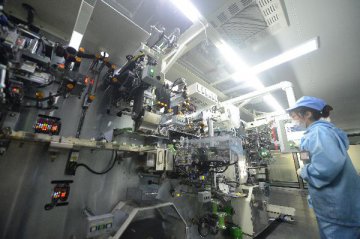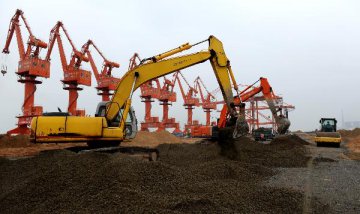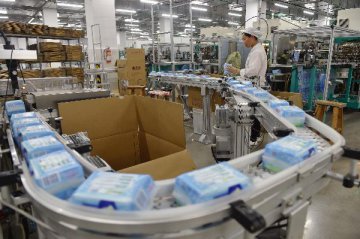British manufacturing continued its robust growth to remain the "bright spot of the economy" with the continuation of the longest period of growth for nearly a quarter of a century.
The Office for National Statistics (ONS) released industrial production figures for October on Friday, showing unchanged growth from September after a period of strong growth, with annual growth in industrial production at 3.6 percent.
MOMENTUM EXPECTED TO CONTINUE
But it was manufacturing output which caught the eye. A monthly increase of 0.1 percentage points in this sector seemed modest, but it came against the backdrop of half a year of strong growth in the sector, and annualized growth that was impressive.
"This was the sixth successive monthly increase in manufacturing output, which is the best run for 23 years," Dr. Howard Archer, chief economic adviser to EY ITEM Club, an economic forecasting firm in London.
"Manufacturing output only edged up by 0.1 percentage point, but that's in the context that it spiked by 0.7 percentage points in the previous month," explained Archer.
The 0.1 percentage point growth looked "uninspiring" said Archer, but the previous run of six months of growth revealed economic momentum in manufacturing to be "resilient".
Manufacturing output was up 3.9 percent year on year and 1.2 percent on the three months to October, which boded well for continued growth in the fourth quarter and into 2018, said Archer.
"The manufacturing sector was very much the bright spark of the economy in the third quarter, and is carrying on decent momentum into the fourth quarter," he said.
Archer added: "November's survey evidence from the CBI and the PMI was very healthy for the manufacturing sector and it seems to be ending the year pretty well. It certainly remains a bright spot for the UK economy."
There is a sterling effect going on in the British economy, with an influence felt from the large fall in the pound, from 1.48 U.S. dollars at the time of the Brexit vote to 1.22 U.S. dollars for much of the past year, and now at 1.34 U.S. dollars.
This is a benefit and a minus for the economy, providing a stimulus to exporters by making them more competitive but also handicapping some of the same exporters through increased raw material and supply chain costs.
Archer noted that the October manufacturing figures were lifted by production of cars for export, which had been boosted by the more competitive pound.
This is in contrast to the domestic British car market which is suffering badly as annual inflation of 3 percent against annual wage rises of about 2 percent subdue spending on big ticket items.
But the handicap of higher raw material costs and supply chain costs that sterling has provided is also resulting in a domestic stimulus.
Archer explained: "There have been some signs, and the Bank of England has noted this, that some businesses are switching to domestic suppliers because of the pound's weakness; that is another area where the manufacturing sector is benefitting because of people switching their supply chain from overseas to Britain because of sterling's drop."
TRADE FIGURES DISAPPOINT
Trade figures for October were also released by the ONS, with the deficit at 1.4 billion pounds (1.88 billion U.S. dollars), much smaller than the consensus expectation of 3 billion pounds.
September's deficit also was revised smaller, to 1.1 billion pounds from 2.8 billion.
"The trade deficit widened because imports rose more than exports -- but if you look at exports volume data of traded goods there was quite reasonable export growth in October," said Archer.
The global economy is growing (the International Monetary Fund predicting in October growth of 3.6 percent for 2017) with global trade doing well and manufacturing across advanced and developing economies expanding.
The production figures showed that car manufacturers increased production by 6.3 percent in October over the same month last year.
This was driven by exports, with the trade figures showing that car exporters recorded the highest ever value of exports in November, worth more than 4 billion pounds.
However, Archer noted that British export performance had been "fairly erratic".
"Overall the trade sector has not done as well as could have been hoped given the amount that sterling has fallen," he said.
"And given the growth in global trade and global growth exports should be in a sweet spot; the environment for exports is pretty good. You'd expect them to be doing well." (1 pound = 1.34 U.S. dollars)
The Office for National Statistics (ONS) released industrial production figures for October on Friday, showing unchanged growth from September after a period of strong growth, with annual growth in industrial production at 3.6 percent.
MOMENTUM EXPECTED TO CONTINUE
But it was manufacturing output which caught the eye. A monthly increase of 0.1 percentage points in this sector seemed modest, but it came against the backdrop of half a year of strong growth in the sector, and annualized growth that was impressive.
"This was the sixth successive monthly increase in manufacturing output, which is the best run for 23 years," Dr. Howard Archer, chief economic adviser to EY ITEM Club, an economic forecasting firm in London.
"Manufacturing output only edged up by 0.1 percentage point, but that's in the context that it spiked by 0.7 percentage points in the previous month," explained Archer.
The 0.1 percentage point growth looked "uninspiring" said Archer, but the previous run of six months of growth revealed economic momentum in manufacturing to be "resilient".
Manufacturing output was up 3.9 percent year on year and 1.2 percent on the three months to October, which boded well for continued growth in the fourth quarter and into 2018, said Archer.
"The manufacturing sector was very much the bright spark of the economy in the third quarter, and is carrying on decent momentum into the fourth quarter," he said.
Archer added: "November's survey evidence from the CBI and the PMI was very healthy for the manufacturing sector and it seems to be ending the year pretty well. It certainly remains a bright spot for the UK economy."
There is a sterling effect going on in the British economy, with an influence felt from the large fall in the pound, from 1.48 U.S. dollars at the time of the Brexit vote to 1.22 U.S. dollars for much of the past year, and now at 1.34 U.S. dollars.
This is a benefit and a minus for the economy, providing a stimulus to exporters by making them more competitive but also handicapping some of the same exporters through increased raw material and supply chain costs.
Archer noted that the October manufacturing figures were lifted by production of cars for export, which had been boosted by the more competitive pound.
This is in contrast to the domestic British car market which is suffering badly as annual inflation of 3 percent against annual wage rises of about 2 percent subdue spending on big ticket items.
But the handicap of higher raw material costs and supply chain costs that sterling has provided is also resulting in a domestic stimulus.
Archer explained: "There have been some signs, and the Bank of England has noted this, that some businesses are switching to domestic suppliers because of the pound's weakness; that is another area where the manufacturing sector is benefitting because of people switching their supply chain from overseas to Britain because of sterling's drop."
TRADE FIGURES DISAPPOINT
Trade figures for October were also released by the ONS, with the deficit at 1.4 billion pounds (1.88 billion U.S. dollars), much smaller than the consensus expectation of 3 billion pounds.
September's deficit also was revised smaller, to 1.1 billion pounds from 2.8 billion.
"The trade deficit widened because imports rose more than exports -- but if you look at exports volume data of traded goods there was quite reasonable export growth in October," said Archer.
The global economy is growing (the International Monetary Fund predicting in October growth of 3.6 percent for 2017) with global trade doing well and manufacturing across advanced and developing economies expanding.
The production figures showed that car manufacturers increased production by 6.3 percent in October over the same month last year.
This was driven by exports, with the trade figures showing that car exporters recorded the highest ever value of exports in November, worth more than 4 billion pounds.
However, Archer noted that British export performance had been "fairly erratic".
"Overall the trade sector has not done as well as could have been hoped given the amount that sterling has fallen," he said.
"And given the growth in global trade and global growth exports should be in a sweet spot; the environment for exports is pretty good. You'd expect them to be doing well." (1 pound = 1.34 U.S. dollars)






















Latest comments